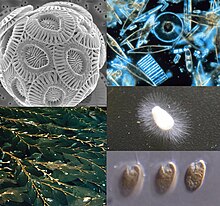
Back أسناخ صبغية Arabic اسناخ صبغيه ARZ Xromistlər Azerbaijani Храмісты Byelorussian Хромисти Bulgarian Chromista BS Cromistes Catalan Chromista Czech Kromistoj Esperanto Chromista Spanish
| Chromista | |
|---|---|

| |
| Chromista collage | |
| Scientific classification (obsolete)
| |
| Domain: | Eukaryota |
| Clade: | Diaphoretickes |
| Kingdom: | Chromista Cavalier-Smith 1981 |
| Groups included | |
| Cladistically included but traditionally excluded taxa | |
Chromista is a proposed but polyphyletic[1][2][3] biological kingdom, refined from the Chromalveolata, consisting of single-celled and multicellular eukaryotic species that share similar features in their photosynthetic organelles (plastids).[4] It includes all eukaryotes whose plastids contain chlorophyll c and are surrounded by four membranes. If the ancestor already possessed chloroplasts derived by endosymbiosis from red algae, all non-photosynthetic Chromista have secondarily lost the ability to photosynthesise. Its members might have arisen independently as separate evolutionary groups from the last eukaryotic common ancestor.[1]
Chromista as a taxon was created by the British biologist Thomas Cavalier-Smith in 1981 to distinguish the stramenopiles, haptophytes, and cryptophytes.[5] According to Cavalier-Smith, the kingdom originally consisted mostly of photosynthetic eukaryotes (algae), but he later brought many heterotrophs (protozoa) into the proposed group. As of 2018, the kingdom was nearly as diverse as the kingdoms Plantae and Animalia, consisting of eight phyla. Notable members include marine algae, potato blight, dinoflagellates, Paramecium, the brain parasite Toxoplasma, and the malarial parasite Plasmodium.[6]
However, Cavalier-Smith's hypothesis of chromist monophyly has been rejected by other researchers, who consider it more likely that some chromists acquired their plastids by incorporating another chromist instead of inheriting them from a common ancestor. This is thought to have occurred repeatedly, so that the red plastids spread from one group to another. The plastids, far from characterising their hosts as belonging to a single clade, thus have a different history from their disparate hosts. They appear to have originated in the Rhodophytina, and to have been transmitted to the Cryptophytina and from them to both the Ochrophyta and the Haptophyta, and then from these last to the Myzozoa.[3]
- ^ a b Cavalier-Smith, Thomas; Allsopp, M. T.; Chao, E. E. (November 1994). "Chimeric conundra: are nucleomorphs and chromists monophyletic or polyphyletic?". Proceedings of the National Academy of Sciences of the United States of America. 91 (24): 11368–11372. Bibcode:1994PNAS...9111368C. doi:10.1073/pnas.91.24.11368. PMC 45232. PMID 7972066.
- ^ Cite error: The named reference
Burki Roger Brown Simpson 2020 pp. 43–55was invoked but never defined (see the help page). - ^ a b Strassert, Jürgen F. H.; Irisarri, Iker; Williams, Tom A.; Burki, Fabien (2021-03-25). "A molecular timescale for eukaryote evolution with implications for the origin of red algal-derived plastids". Nature Communications. 12 (1): 1879. Bibcode:2021NatCo..12.1879S. doi:10.1038/s41467-021-22044-z. ISSN 2041-1723. PMC 7994803. PMID 33767194.
- ^ Cite error: The named reference
parfreywas invoked but never defined (see the help page). - ^ Cavalier-Smith, Thomas (1981). "Eukaryote kingdoms: seven or nine?". Bio Systems. 14 (3–4): 461–81. doi:10.1016/0303-2647(81)90050-2. PMID 7337818.
- ^ Cavalier-Smith, Thomas (2018). "Kingdom Chromista and its eight phyla: a new synthesis emphasising periplastid protein targeting, cytoskeletal and periplastid evolution, and ancient divergences". Protoplasma. 255 (1): 297–357. doi:10.1007/s00709-017-1147-3. PMC 5756292. PMID 28875267.
© MMXXIII Rich X Search. We shall prevail. All rights reserved. Rich X Search